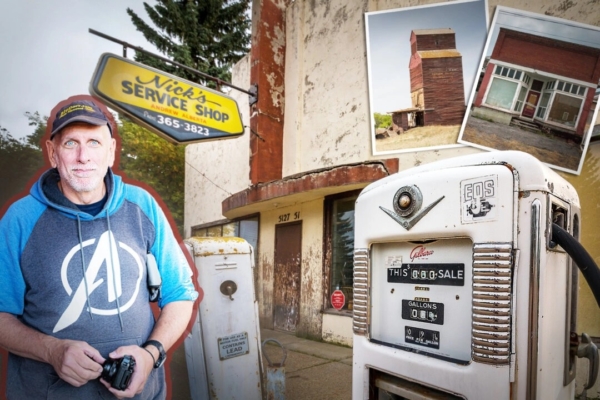Chris Doering has added a new report about an old rural hotel in Alberta on his website, documenting the archives of 20th-century “mom and pop shops” and other buildings, further enhancing his collection.
In an interview with “Epoch Times”, Doering mentioned that places like the Acme Hotel, Jack’s Shoe Store, and Sam’s Garage are quickly disappearing. His exploration of old businesses began thirty years ago as a hobby, but in recent years, some companies have hired him to investigate the history of commercial buildings, turning his hobby into a full-time job.
He believes that classic, old-fashioned corner shops may never make a comeback. “They simply can’t compete with big corporations,” Doering said. “Mom and pop shops are up against chain stores—others have purchasing power, convenience, and various other advantages.”
At 60 years old, Doering from Calgary now spends his time reviewing old newspaper archives, writing reports, and driving to abandoned commercial buildings in Western Canada, with his wife Connie Biggart as his travel companion. They not only take photos but also immerse themselves in the atmosphere and nostalgia, documenting their experiences on the website “Off the Beaten Path with Chris and Connie.”
Their recent adventure project, the “Beer Parlour Project,” led them to explore several rural villages in British Columbia, Alberta, and Saskatchewan, recording and studying dozens of bars and small taverns.
“I have always been interested in abandoned or historic things,” he said. “Anything related to business piques my interest.”
During a trip to Bruderheim town, Doering and Biggart stumbled upon the Victoria Hotel, built in 1906 and still operating to this day. Bruderheim is a small town east of Edmonton, Alberta, with only 1329 residents. While exploring, they met Hazel, who had worked as a waitress there, pointing to an old man wearing a worn-out baseball cap, saying, “That’s old Willie over there, he comes every afternoon.”
The couple conversed with the locals, took photos, and delved deep into the history of the Victoria Hotel.
Doering’s hobby turned serious after he and his wife decided to close their clothing manufacturing company in 2010. “The company was doing well, but it was just too hard, we would have been dragged down if we continued like that,” he said.
His wife suggested, “Why don’t you do something you’re interested in?” Encouraging him to take his hobby seriously, he accepted the advice.
After establishing an online platform, Doering quickly realized that people are nostalgic for the simplicity of the past—where storefronts displayed signs of Coca-Cola and Pepsi, and store owners knew your name.
“People have fond memories, but at the same time, they still shop at chain stores because it’s more convenient,” he said.
During a journey through the mountains to Blairmore village in British Columbia, Doering discovered Catonio’s Groceteria. This store was operated by Giovanni Battista “John” Catonio, an Italian family venture akin to the “7-Eleven” of that era, selling Italian products.
“You can tell from a distance that it’s a corner shop just by looking at the architecture,” Doering said. The square red brick building with wooden siding still stands today.
“We found the last mention of them in the phonebook was in the early 1980s, then they disappeared,” he said. The Catonio family moved out in the 1950s, and it seemed a plumbing company took over later on.
No one knows for sure when the building was abandoned. Now it stands, as faded as an old Pepsi sign on a western wall.
In his travels far and wide, Doering occasionally stumbles upon places with more “gray areas.”
In February of this year, he set out from Calgary heading east, crossing vast prairies near the border with Saskatchewan. In the small village of Sibbald, with a population of about 30 to 40 people, he found a place called the “Sibbald Gentleman’s Club.” Speculating on who might’ve been the customers of this club in the 1980s, Doering wrote on his website: “Local oilfield workers with money in their pockets, likely seeking some excitement and release.” He added, “The club was the last operating commercial establishment in town, and now the main street is quiet.” Records show that the club closed around 2015.
However, Doering’s records not only focus on corner shops, hotels, and nightclubs, his reports cover almost all types of businesses.
He has tracked abandoned mountain railways due to road construction—he uncovered tracks through tall grass. He has documented decommissioned grain elevators—the “prairie sentinels” now riddled with bullet holes in Western Canada. He has also written about the demise of some commercial facilities in Calgary, like the now-defunct Kart Gardens go-kart track and the Highland Golf Course which closed about twelve years ago.
In a photograph, Doering points to a closed business adjacent to a small town water tower, lamenting. “Jack’s Shoe Store was a well-established old shop that Jack closed when he got older, not even clearing out the inventory,” he said. “When you look through the window, you can still see shoes on the shelves, some still awaiting repair.”
On his website, he wrote that this shoe store is now “just another closed small-town business on the prairie. It’s a common trend—businesses closing one by one, the local economy shrinking. Rinse and repeat. The situation revealed by the data is worrying.”
Faced with all the decline and decay, does Doering wish to go back to the past? Would he like to see the Catonio family and cobbler Jack return to the streets?
“Yes, I miss that era a lot,” he said.
Doering often fantasizes about walking into Jack’s Shoe Store and chatting about the weather with Jack. “It’s a very personal, very close feeling,” he added. “And now, of course, everything has become very impersonal. I know the world is changing, and I accept that.”
The original article titled “Alberta Man Digs Up Hidden History of Abandoned Businesses From Simpler Times—See the Photos” was published on the English “Epoch Times” website.

